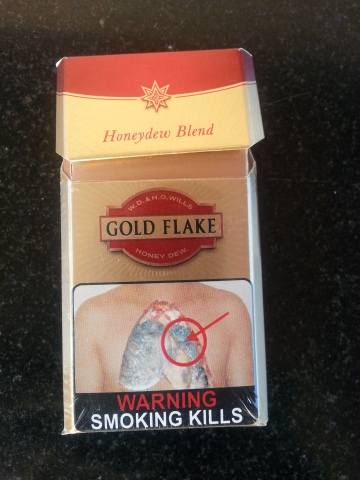
Besides the size of the pictorial warning, what matter most is how shocking the warnings are. – Photo: R. Prasad
What is the connection between a scorpion, tobacco and cancer? Well, absolutely nothing. If any, it is the crab that is an international symbol of cancer. Yet, the previous government chose the scorpion as one of the pictorial warnings on tobacco products!
Though the current controversy on pictorial warnings has finally boiled down to the size of the warnings, size is just one of the critical aspects. Even if the Parliamentary Committee decides to heed to the Prime Minister’s order of bigger pictorial warnings, the very purpose of pictorial warnings can be undermined and destroyed by choosing meaningless and ineffectual ones, as the previous government did.
“More graphic (and often shocking) images are considered to have a greater impact and to be more likely to lead to behavioural change”, notes a WHO report.
In the UK, the most graphic pictures that revealed the negative health impacts of smoking received the most votes from the people. Ditto in the case of Canada. “Participants consistently expected or wanted to be shocked by [health warning messages], or emotionally affected in some ways. … Emotional impact of a warning appeared to predict its ability to inform and/or motivate thoughts of quitting,” notes a 2009 WHO report.
The positive effects of shocking images on tobacco users have been well documented. Nearly 67 per cent of smokers in Brazil and New Zealand and 44 per cent in the case of Canada and Thailand wanted to quit smoking as a result of graphic pictorial warnings.
Similarly, nearly 54 per cent of people in Brazil and Thailand and 58 per cent in Canada changed their opinion about the health consequences of smoking on seeing shocking pictorial warnings. These were some of the findings of the WHO on the impact of pictorial warnings on current users.
Tobacco packaging is the last vehicle used by tobacco companies to reinforce their brand, make their products more appealing and entice new users to start consuming tobacco. In the process, they successfully distract consumers from the harsh reality of the harmful effects of tobacco on health.
The use of shocking pictorial warnings thus turns the power of packaging on its head. While negating the power of the tobacco companies to reinforce and build the brand, pictorial warnings convey “clear and immediate message” of the harmful effects of tobacco consumption at a very little or no cost to the government.
If pictorial warnings can create awareness of all the harmful effects of tobacco consumption even among a large chunk of the educated population, the benefits will be tremendously high in the case of poor, illiterate people.
Tobacco companies are too well aware of the huge adverse effect of large, shocking pictorial warnings on their bottom line. And they will pull out all the stops to dilute the amendment, as was seen recently with the MPs batting for the tobacco companies.
The government had increased the taxes on tobacco products and listed out a few measures in a draft Bill to curb consumption — prohibiting the sale of the products to those under 21 years, prohibiting the sale of cigarettes/bidis in loose, banning the display of tobacco products at outlets, and banning the use of brand name of tobacco products to promote non-tobacco products. But it is only in the case of pictorial warning that there has been a reaction by the MPs, who are acting on behalf of the tobacco companies.
The reasons are quite obvious. Except in prohibiting the use of tobacco brand names to promote non-tobacco products and increasing the excise duty on tobacco products, none of the other measures listed in the draft Bill by the government can ever be effectively enforced. Even in the case of taxes, the hike was limited to cigarettes and chewing tobacco (smokeless tobacco) and bidis were exempted from it. This is despite the fact that nearly 85 per cent of smokers in India consumed bidis.
Even in the case of cigarettes, the net negative effect of tax hike on consumption will be very limited. Since there are four different cigarette lengths sold in the country, consumers can always switch over to smaller length cigarettes and thus escape the brunt of the tax hike. Also, the hike is not linked to inflation and, hence, the increased tax will, in due course, be insignificant.
But, it is completely different in the case of pictorial warnings. They will turn out to be the biggest deterrent in the case of children and young, new users, and current users are very likely to reduce consumption and even quit smoking.
An October 21, 2014 editorial in The Hindu had noted: “How well the government resists such pressure [to dilute the amendment] will show how determined it is to win the war against tobacco. Since one million people in India die each year because of tobacco use, the government should not sacrifice proven and obvious health benefits at the altar of commercial advantage.”